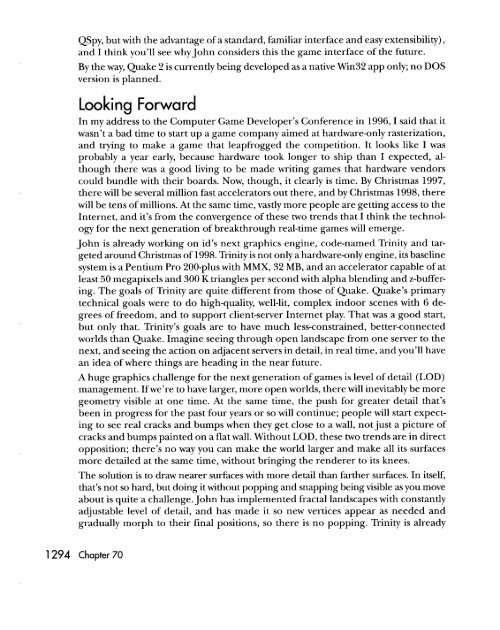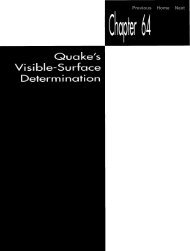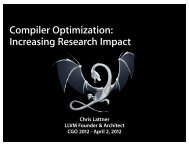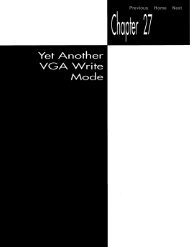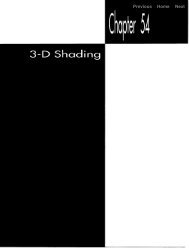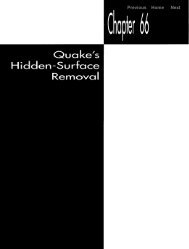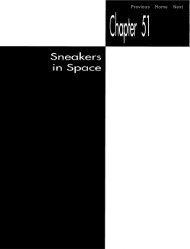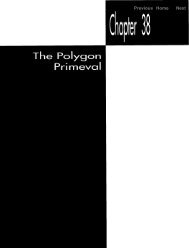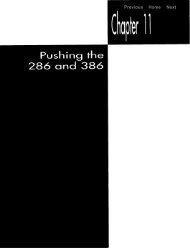quake: a post-mortem and a glimpse into the future
quake: a post-mortem and a glimpse into the future
quake: a post-mortem and a glimpse into the future
You also want an ePaper? Increase the reach of your titles
YUMPU automatically turns print PDFs into web optimized ePapers that Google loves.
QSpy, but with <strong>the</strong> advantage of a st<strong>and</strong>ard, familiar interface <strong>and</strong> easy extensibility),<br />
<strong>and</strong> I think you’ll see why John considers this <strong>the</strong> game interface of <strong>the</strong> <strong>future</strong>.<br />
By <strong>the</strong> way, Quake 2 is currently being developed as a native Win32 app only; no DOS<br />
version is planned.<br />
Looking Forward<br />
In my address to <strong>the</strong> Computer Game Developer’s Conference in 1996, I said that it<br />
wasn’t a bad time to start up a game company aimed at hardware-only rasterization,<br />
<strong>and</strong> trying to make a game that leapfrogged <strong>the</strong> competition. It looks like I was<br />
probably a year early, because hardware took longer to ship than I expected, although<br />
<strong>the</strong>re was a good living to be made writing games that hardware vendors<br />
could bundle with <strong>the</strong>ir boards. Now, though, it clearly is time. By Christmas 1997,<br />
<strong>the</strong>re will be several million fast accelerators out <strong>the</strong>re, <strong>and</strong> by Christmas 1998, <strong>the</strong>re<br />
will be tens of millions. At <strong>the</strong> same time, vastly more people are getting access to <strong>the</strong><br />
Internet, <strong>and</strong> it’s from <strong>the</strong> convergence of <strong>the</strong>se two trends that I think <strong>the</strong> technology<br />
for <strong>the</strong> next generation of breakthrough real-time games will emerge.<br />
John is already working on id’s next graphics engine, code-named Trinity <strong>and</strong> targeted<br />
around Christmas of 1998. Trinity not is only a hardware-only engine, its baseline<br />
system is a Pentium Pro 200-plus with MMX, 32 MB, <strong>and</strong> an accelerator capable of at<br />
least 50 megapixels <strong>and</strong> 300 K triangles per second with alpha blending <strong>and</strong> z-buffering.<br />
The goals of Trinity are quite different from those of Quake. Quake’s primary<br />
technical goals were to do high-quality, well-lit, complex indoor scenes with 6 degrees<br />
of freedom, <strong>and</strong> to support client-server Internet play. That was a good start,<br />
but only that. Trinity’s goals are to have much less-constrained, better-connected<br />
worlds than Quake. Imagine seeing through open l<strong>and</strong>scape from one server to <strong>the</strong><br />
next, <strong>and</strong> seeing <strong>the</strong> action on adjacent servers in detail, in real time, <strong>and</strong> you’ll have<br />
an idea of where things are heading in <strong>the</strong> near <strong>future</strong>.<br />
A huge graphics challenge for <strong>the</strong> next generation of games is level of detail (LOD)<br />
management. If we’re to have larger, more open worlds, <strong>the</strong>re will inevitably be more<br />
geometry visible at one time. At <strong>the</strong> same time, <strong>the</strong> push for greater detail that’s<br />
been in progress for <strong>the</strong> past four years or so will continue; people will start expecting<br />
to see real cracks <strong>and</strong> bumps when <strong>the</strong>y get close to a wall, not just a picture of<br />
cracks <strong>and</strong> bumps painted on a flat wall. Without LOD, <strong>the</strong>se two trends are in direct<br />
opposition; <strong>the</strong>re’s no way you can make <strong>the</strong> world larger <strong>and</strong> make all its surfaces<br />
more detailed at <strong>the</strong> same time, without bringing <strong>the</strong> renderer to its knees.<br />
The solution is to draw nearer surfaces with more detail than far<strong>the</strong>r surfaces. In itself,<br />
that’s not so hard, but doing it without popping <strong>and</strong> snapping being visible as you move<br />
about is quite a challenge. John has implemented fractal l<strong>and</strong>scapes with constantly<br />
adjustable level of detail, <strong>and</strong> has made it so new vertices appear as needed <strong>and</strong><br />
gradually morph to <strong>the</strong>ir final positions, so <strong>the</strong>re is no popping. Trinity is already<br />
1294 Chapter 70


